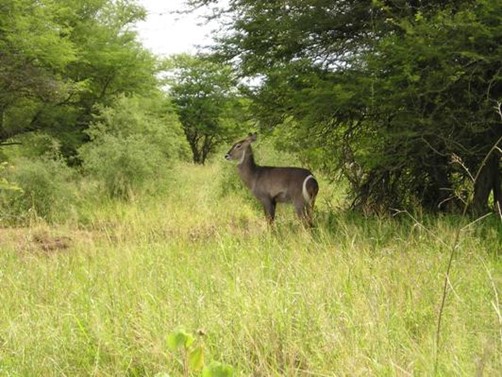68 Wild Animals, Where are They?
Rick Bein
The Mozambique government wants to cash in on the kind of tourism that the South Africans have with Kruger National Park. Kruger is probably the foremost wild animal park in the world where you are guaranteed to see lions, elephants, buffalo etc. Limpopo Park abuts up against Kruger on the Mozambique side of the boundary where the South Africans have been donating hundreds of different surplus wild animals. But after three days in Limpopo Park, we saw only a few impalas, 3 kudus and a waterbuck. What happened to the other donated animals?

Waterbuck in Limpopo Park, Mozambique. Photo by Rick Bein 2005.
The 26 thousand tribal villagers who still live in Limpopo Park have not had much say about all these animals being released in their back yards, have gone to great extremes to protect themselves, their cattle, and their crops. After the lions ate a few cows and the elephants trashed a few fields, they were shot dead, and the rest of the wild animals have fled back into Kruger Park. Now the villagers have established who is at the top of the food chain, while acting in collusion with poachers. The government can’t understand why the tourists aren’t flocking in to spend the big bucks!

Farmstead in Southern Mozambique. Raised corn crib is a prime target for elephants. Photo by Rick Bein 2005.
Against this backdrop of four different stake holders: 1) the animal park managers, 2) Western donor agencies, 3) Mozambique government and 4) the local villagers, a much more complex situation is apparent. The objective of a National Park is primarily to provide area where nature can exist, protected from the over exploitation of human activity. It is the current view that there is an inherent advantage in maintaining natural areas to promote biodiversity as well as to support educational, recreational, and scientific research based on the continuous presence of wildlife species. The cost of providing natural areas may be provided through a number of scenarios. Governments frequently finance the maintenance of such parks, but under some circumstance’s parks are maintained by their recreational users. I have seen plenty of instances in which recreational users are charged very high fees which are not put back into the parks!
A 2022 article from the Mozambique newspaper “Noticias” relates how new animals are continuing to be (re)introduced.
RESTOCKING OF BUFFALOES IN LIMPOPO NATIONAL PARK
Maputo, 16 Sep (AIM ) – A herd of 50 buffaloes has been imported
into Mozambique’s Limpopo National Park, as part of an ambitious
restocking programme, reports Thursday’s issue of the Maputo
daily “Noticias”.
About 3,000 animals of various species have been imported by
the park, so far, mostly from South Africa. This is around half
of the 6,000 targeted by the programme, that started in 2002.
Gilberto Vicente, of the park management, said that the
buffaloes were brought into the country after going through all
veterinary procedures to ensure that they are not suffering from
any disease.
All the animals are being monitored, and “if there is
evidence that any animal is affected by any disease it will be
either slaughtered or put in quarantine”, he said.
He said that the veterinary authorities will be monitoring
the herds to ensure that they will not spread any diseases in the
about 25,000 hectares of the park.
Vicente explained that bringing in buffaloes is a pilot
experience, to try and ensure ecological balance. Buffaloes play
an important role in the food chain, he said, because they eat
high grass, and open up areas for other herbivores to graze.
The Mozambican Conservation and Veterinary Committee, has
expressed satisfaction with the strict observation of the
restocking regulations, and hopes that this will be consolidated
and extended to the so called “ecological corridors”, that were
opened with the removal of the border fence between Mozambique
and South Africa.
The Limpopo National Park is part of the Greater Limpopo
Trans-frontier Park, which also includes South Africa’s Kruger
Park, and the Gonorezhou park in Zimbabwe.

